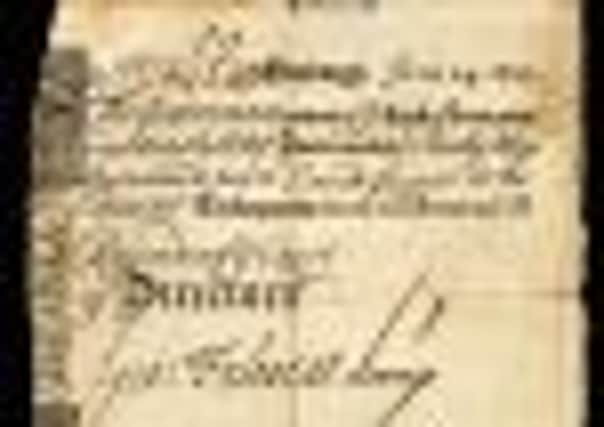Retired bank worker coins it in with rare note


The black and white £12 note was issued in Edinburgh by Scotland’s oldest bank, the Bank of Scotland, on June 24, 1723, 28 years after it was founded and 23 years before the Battle of Culloden.
That year was also the year Scottish economist Adam Smith was born.
Advertisement
Hide AdAdvertisement
Hide AdAuctioneer Spink says the Edinburgh £12 note is in “very fine” condition and that in this condition it is “excessively rare”.
It is expected to sell for between £1800 and £2200 at Spink in Bloomsbury, London, next Monday.
It is the most valuable banknote among the 300 Scottish banknotes, some rare and historically important, put up for sale by retired bank worker Alasdair Macdonald and which are set to fetch between £79,200 and £105,800 in total.
The 1723 £12 note – with the word “Edinburgh” prominently displayed at the top – was made payable to David Spence “or the bearer” and it also features the signatures of two Bank of Scotland officials, George Falconer and a Mr Drummond.
It is not the only Edinburgh note in the sale.
Advertisement
Hide AdAdvertisement
Hide AdA 1799 Royal Bank of Scotland one guinea note is expected to sell for between £280 and £350 at the auction.
Mr Macdonald started his working life nearly 60 years ago and recalls how his collecting passion began.
He said: “Like many things in my life I became involved in note collecting by accident rather than by design.
“In 1952, I entered the service of the Bank of Scotland at their branch in Troon, Ayrshire, as an apprentice straight from school. It was a small office with a manager, a teller and myself.
Advertisement
Hide AdAdvertisement
Hide Ad“The largest customer was the local Co-Operative Society, which paid in daily around £1200, the bulk of which was in single notes. To avoid a hold-up in the service at the counter, the practice was for the teller to count the large notes in the pay-in, but to merely “score” the bundles of single notes, which were then passed to the apprentice to sort and make up into bundles for each bank and balance.
“One day, amongst the notes, a 1927 brown, green, lilac and white one pound note turned up and I asked the teller what it was. He did not know, but the manager said it was ‘an old Treasury note and would have to be sent off to London ‘for collection’.
“So I asked the manager if he would object if I just bought it as a curio and he agreed.”